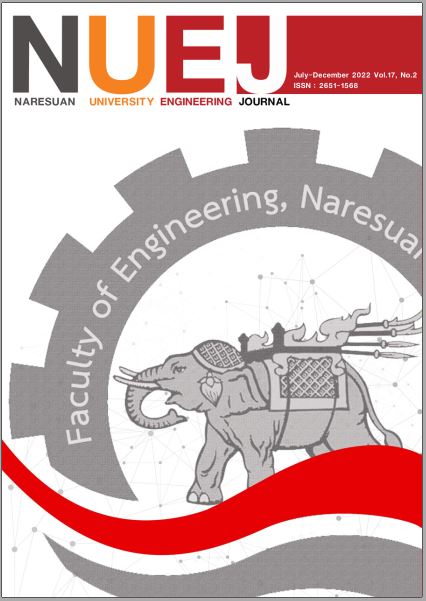Tracing Crop Water Requirement in the Pumping, Gravitational and Inundation Irrigation Schemes Using Cloud–Based IrriSAT Application
Main Article Content
Abstract
Tracing crop coefficient (Kc) at all the stages of crop growth is commonly essential for an accurate estimation of crop water use. This study applied the cloud–based IrriSAT application to trace the dynamic values of crop coefficient in three different sorts of irrigation schemes; pumping, gravitational and inundation irrigation for estimating crop water requirement in the Chao Phraya River Basin (CPYRB), Thailand. Three selected irrigation schemes; Bang Bal (BB), Thabua (TB), and Yom–Nan (YN) representing pumping, gravitational, and inundation irrigation schemes were selected to trace crop coefficient values of in–season and off–season crops and to estimate long–term crop water requirement (ETc) from 2015–2020. The results of dynamic values of Kc–IrriSAT were verified and adjusted with average Kc established by the Royal Irrigation Department (Kc–RID) which were calculated as a function of Kc from field observation for the different types of crops and accumulated area size monitored by the Geo–Informatics and Space Technology Development Agency (GISTDA). The results revealed the similar patterns of average Kc generated by IrriSAT corresponding to the average Kc–RID. After the calibration procedure was successfully done, the correlations between Kc–IrriSAT adjusted and average Kc–RID for BB, TB, and YN irrigation schemes are relatively higher with R2 of 0.8304, 0.8466, and 0.8314, respectively. In addition, it shows the explicit variability on monthly and yearly crop water demands of these three sorts of irrigation schemes when the adjusted Kc–IrriSAT was employed. It would be concluded that cloud–based IrriSAT application can be a very supportive tool in estimating the actual crop water requirement particularly for irrigators to evaluate the current status of irrigation water use and to improve the irrigation efficiency at the field scale.
Article Details

This work is licensed under a Creative Commons Attribution-NonCommercial-NoDerivatives 4.0 International License.
References
Allen, R., Wright, J.L., Pruitt, W.O., Pereira, L., & Jensen, M. (1998). Water Requirements. Design and Operation of Farm Irrigation Systems 1998, 29, DOI: 10.1007/978–94–011–5131–3_2.
Board of Investment of Thailand (BOI). (20201). Thailand Advantages: Trade Spotlight. Retrieved from https://www.boi.go.th/index.php?page=thailand _advantages.
Demaison, J., & Vogt, N. (2020). Least–Squares Method. Accurate Structure Determination of Free Molecules, 233–263. DOI: 10.1007/978–3–030–60492–9_9.
Hornbuckle, J., Vleeshouwer, J., Ballester, C., Montgomery, J., Hoogers, R., & Bridgart, R. (2016). Estimating the crop coefficient. IrriSAT Technical Reference, 1–17.
Hydro–Informatics Institute (HII). (2012a). 25 Basins Database Development Project: Ping Basin. Bangkok: HII.
Hydro–Informatics Institute (HII). (2012b). 25 Basins Database Development Project: Nan Basin. Bangkok: HII.
Hydro–Informatics Institute (HII). (2012c). 25 Basins Database Development Project: Chao Phraya Basin. Bangkok: HII.
Hydro–Informatics Institute (HII). (2012d). 25 Basins Database Development Project: Thachin Basin. Bangkok: HII.
Kyaw, K. M., Rittima, A., Phankamolsil, Y., Tabucanon, A. S., Sawangphol, W., Kraisangka, J., Talaluxmana, Y., & Vudhivanich, V. (2020). Tracing Crop Water Demand in the Lower Ping River Basin, Thailand using Cloud–Based IrriSAT Application. Proceedings of the 22nd IAHR–APD Congress 2020, September 14–17, Sapporo, Japan.
Ministry of Agriculture and Cooperatives of the Kingdom of Thailand (MOAC). (2016). Economic characteristics of Thailand. Agricultural Development Plan No. 12, Thailand, 12–81.
National Research Council of Thailand (NRCT). (2022). Multiple Reservoir Re–Operation System for Long–Term Water Supply Management in the Greater Chao Phraya River Basin Using Artificial Intelligence Technique (Phase 2). Bangkok: NRCT.
Pandey, V. (2021). Estimation of Crop Water Requirement. Fertigation Technologies for Micro Irrigated Crops, Apple Academic Press, 109–136. DOI: 10.1201/9781003084136–10.
Pereira, L.S., & Alves, I. (2005). Crop Water Requirement. Encyclopedia of Soils in the Environment, 322–334. DOI: 10.1007/s12205–013–1638–5.
Raes, D. (2012). The ETo Calculator: Reference Manual Version 3.2. Food and Agriculture Organization of the United Nations, Italy.
Saha, A. (2020). How to use FAO developed ETo Calculator to estimate evapotranspiration from weather data. Determination of Hydro–geological Properties for Upper Soil Layer Regarding Irrigation design and Groundwater Recharge in Sylhet region, DOI: 10.13140/RG.2.2.27723.34080.
Singhapreecha, C. (2014). Economy and Agriculture in Thailand. Faculty of Economics, Chiang Mai University.
Thanadachophol, T., Teamsuwan, V., Udomsap, L., Wongsamut, W., & Chamnankaew, U. (2020). An Analysis of Water Management in 2020 Drought Conditions, Thailand, 287–288.


